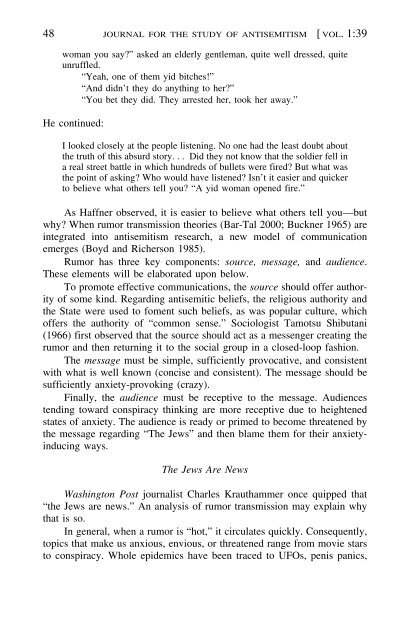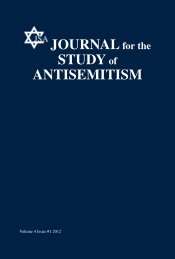Antisemitism as a Specific Phenomenon - Journal for the Study of ...
Antisemitism as a Specific Phenomenon - Journal for the Study of ...
Antisemitism as a Specific Phenomenon - Journal for the Study of ...
You also want an ePaper? Increase the reach of your titles
YUMPU automatically turns print PDFs into web optimized ePapers that Google loves.
48 JOURNAL FOR THE STUDY OF ANTISEMITISM [ VOL. 1:39<br />
woman you say” <strong>as</strong>ked an elderly gentleman, quite well dressed, quite<br />
unruffled.<br />
“Yeah, one <strong>of</strong> <strong>the</strong>m yid bitches!”<br />
“And didn’t <strong>the</strong>y do anything to her”<br />
“You bet <strong>the</strong>y did. They arrested her, took her away.”<br />
He continued:<br />
I looked closely at <strong>the</strong> people listening. No one had <strong>the</strong> le<strong>as</strong>t doubt about<br />
<strong>the</strong> truth <strong>of</strong> this absurd story. . . Did <strong>the</strong>y not know that <strong>the</strong> soldier fell in<br />
a real street battle in which hundreds <strong>of</strong> bullets were fired But what w<strong>as</strong><br />
<strong>the</strong> point <strong>of</strong> <strong>as</strong>king Who would have listened Isn’t it e<strong>as</strong>ier and quicker<br />
to believe what o<strong>the</strong>rs tell you “A yid woman opened fire.”<br />
As Haffner observed, it is e<strong>as</strong>ier to believe what o<strong>the</strong>rs tell you—but<br />
why When rumor transmission <strong>the</strong>ories (Bar-Tal 2000; Buckner 1965) are<br />
integrated into antisemitism research, a new model <strong>of</strong> communication<br />
emerges (Boyd and Richerson 1985).<br />
Rumor h<strong>as</strong> three key components: source, message, and audience.<br />
These elements will be elaborated upon below.<br />
To promote effective communications, <strong>the</strong> source should <strong>of</strong>fer authority<br />
<strong>of</strong> some kind. Regarding antisemitic beliefs, <strong>the</strong> religious authority and<br />
<strong>the</strong> State were used to foment such beliefs, <strong>as</strong> w<strong>as</strong> popular culture, which<br />
<strong>of</strong>fers <strong>the</strong> authority <strong>of</strong> “common sense.” Sociologist Tamotsu Shibutani<br />
(1966) first observed that <strong>the</strong> source should act <strong>as</strong> a messenger creating <strong>the</strong><br />
rumor and <strong>the</strong>n returning it to <strong>the</strong> social group in a closed-loop f<strong>as</strong>hion.<br />
The message must be simple, sufficiently provocative, and consistent<br />
with what is well known (concise and consistent). The message should be<br />
sufficiently anxiety-provoking (crazy).<br />
Finally, <strong>the</strong> audience must be receptive to <strong>the</strong> message. Audiences<br />
tending toward conspiracy thinking are more receptive due to heightened<br />
states <strong>of</strong> anxiety. The audience is ready or primed to become threatened by<br />
<strong>the</strong> message regarding “The Jews” and <strong>the</strong>n blame <strong>the</strong>m <strong>for</strong> <strong>the</strong>ir anxietyinducing<br />
ways.<br />
The Jews Are News<br />
W<strong>as</strong>hington Post journalist Charles Krauthammer once quipped that<br />
“<strong>the</strong> Jews are news.” An analysis <strong>of</strong> rumor transmission may explain why<br />
that is so.<br />
In general, when a rumor is “hot,” it circulates quickly. Consequently,<br />
topics that make us anxious, envious, or threatened range from movie stars<br />
to conspiracy. Whole epidemics have been traced to UFOs, penis panics,














